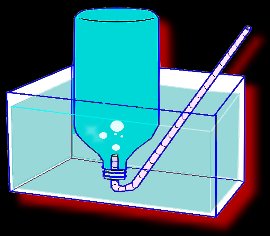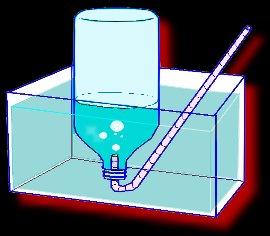The strength of your lungs can be measured by how hard and long you can blow, when there is something for your air to push against. This test is commonly done by doctors to check for lung diseases such as asthma and emphysema. Here's how you can set up the test for yourself, to check your own lung power.
You'll need a big container full of water, a big clear plastic pop bottle, some clear tape, and several straws. A second person is needed to hold the pop bottle while you blow.
Fill the big pop bottle full to the top with water, and while holding your hand over the opening, turn it upside down in the water container.
 Now attach several straws together with tape. The kind with one end that bends is best, since now you have to insert one end of this long straw under the water and into the neck of the bottle, ... as shown above.
Now attach several straws together with tape. The kind with one end that bends is best, since now you have to insert one end of this long straw under the water and into the neck of the bottle, ... as shown above.
Take a deep breath, and blow into the straw as long as you possibly can, until every last bit of air has been exhausted from your lungs.
What happens? The air you blew into the bottle forced out an equal volume of water. If you take out the bottle and hold it right side up, you'll see there's water left in the bottle, with space above.
The amount of air above the water represents the volume of air your lungs can hold.

You can directly measure your lung volume by using a metric measuring cup. Pour water back into the bottle until it's full again, keeping track of how much you had to add. This amount, in millilitres, is the capacity of your lungs. (It's also the volume in cubic centimetres; divide by 1000 to get your lung capacity in litres.)
People with lung problems, or people who smoke, have many of the 'pockets' inside their lungs plugged up with gunk, and can't hold as much air. As a result, they don't do well in sports or other strenuous activities.
You might like to find out how your lungs work by building a model!
|